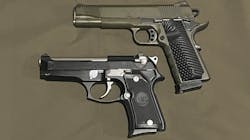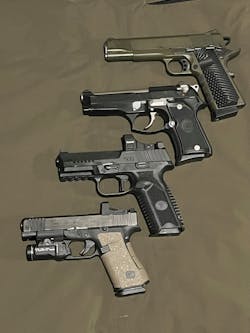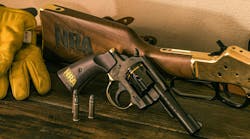- - - - - - - - - -
Just the other day (as this is typed) I was talking with a Chief of Police in the Washington, D.C., metropolitan area. His agency is getting ready to change duty handguns and I was curious as to what options they were considering. At one point he said, “Well, the firearms team has given me a list of acceptable full-size duty handguns to choose from.” Me being me, I had to ask, “What is a ‘full-size duty handgun?’ ” He looked startled, as if it wasn’t obvious.
This article appeared in the July/August issue of OFFICER Magazine. Click Here to subscribe to OFFICER Magazine.
It’s really not obvious when you consider it. What makes a full-size duty handgun such? In 1984, the duty handgun of our armed forces was the Government Model 1911 .45ACP. It had a 5” barrel, carried 7+1 rounds of ammo, had fixed sights and weighed almost two and a half pounds empty. One year later, the duty handgun of our armed forces was the Beretta M9 9mm. It had a 5” barrel, carried 15+1 rounds of ammo, had fixed sights and weighed just over two pounds unloaded. Both were “full-size duty handguns,” but were of different calibers, very different capacities and were a few ounces different in empty weight.
A few years later, in the early 1990s, an experienced firearms instructor made the observation that perhaps agencies carrying the Beretta 92FS (civilian equivalent of the Beretta M9) should switch to the Glock Model 19 (G19). The G19 held just as many rounds of ammo (15+1), was the same caliber (9mm) and had the same sight radius (the distance between the front and rear sight) as the Beretta 92FS. What was the difference? The G19 was roughly 2/3 the volume (it was 1/3 smaller) and 2/3 the weight. The weight difference was mostly due to the polymer frame and the size difference was mostly due to the shorter barrel: the G19’s barrel was about one inch shorter than the Beretta’s.When the question was asked why the G19 couldn’t be an agency’s duty weapon, one answer received was, “Because it’s a midsize handgun.” That answer was based on the fact that Glock made the Model 17, bigger than the G19, and the Model 26, smaller than the G19; so the G19 was the middle sized gun. The person answering went on to add, “With the G17 available, why would any agency use the G19 as a duty handgun and give up the two extra round in capacity that the G17 offered?”
That’s a good question, but it assumes that more bullets are always better. Most experienced shooters and firearms instructors would agree but then some of them carry, as their preferred personal sidearm, a version of the Government Model 1911. The discussion about duty sidearms often focuses, in today’s world, on handguns with polymer frames, maximum capacity magazines in whatever the selected caliber is, mountable accessories such as lights and red dot sights and, as probably the last considerations, overall size and weight. What is rarely considered is officer hand size and, for experienced officers, weapon and/or caliber preferences.
There are a couple agencies I’m aware of that allow officers to choose their own weapons within certain criteria. At least one agency I know of used to have a duty weapon of a given manufacture and design, but it had two different capacities, and the agency issued each officer the larger or smaller capacity weapon based on measured hand size. In that case, the ‘full-size duty handgun’ carried either 8+1 or 13+1 rounds in 9mm.
Now let’s throw some abstract connections into the mix: Glock, as the example, makes several handguns specifically designed for concealed carry, like the Models 43 and 48. Both are slim frame weapons with single-stack magazines, both chambered in 9mm. At this point, there’s not much use in arguing whether the 9mm is an acceptable duty caliber; it’s just too widely used and has been the NATO standard for decades. But the G43 only holds six rounds in a magazine and it’s a very small gun: not really much use as a duty sidearm, right? And the G48 only holds 10 9mm rounds so it’s not much… wait. Ten rounds of 9mm is more than the seven or eight rounds of .45ACP in ‘full size duty handguns,’ so why would 10 rounds of 9mm be unacceptable? Maybe it’s the overall size of the weapon? (I’m not going into the 9mm vs .45ACP decades old argument, and it only gets worse when you throw in .40S&W and .357Sig.)
The G43 is specifically designed for concealed carry or use as a backup gun. Its barrel length is just under 3.5”. The G48, also primarily designed for the concealed carry market, has a barrel length just over 4”. Some might argue that anything short of a five-inch barrel is too short for a duty weapon, but decades of officers carrying revolvers with four inch barrels would dispel that argument.
So, we’ve identified that the 9mm is acceptable as a duty caliber; we’ve identified that four inches of barrel is sufficient length; and we’ve identified that ten rounds of magazine capacity is also sufficient. The Glock 48MOS will support both weapon mounted lights and a red dot sight, either or both of which might be desired on a duty weapon. Add to that the availability (currently after market only) of 15-round magazines that fit flush in the G48 frame, and this “mid-size” handgun suddenly has the same capacity as the Beretta M9 of old. +5 floor plates are available for those 15-round magazines too, so the gun could hold 21 rounds of 9mm total if the need was seen.
The question then becomes: why would such a weapon be unacceptable for duty use? Because it’s not a ‘full-size duty handgun’?
As was said at the beginning of the article, the point is not to say, “Your duty handgun should be X,” but to make people think about what makes a weapon acceptable or not for duty use. A few agencies in this country allow their officers, within certain guidelines, to choose their own duty weapon. In those cases, the officers are likely selecting, again—within the guidelines—those weapons that they are most comfortable with, competent with and confident in the performance of. At the end of the day, perhaps that is what should be most focused on instead of round count, barrel length and overall weight.
This article appeared in the July/August issue of OFFICER Magazine.




